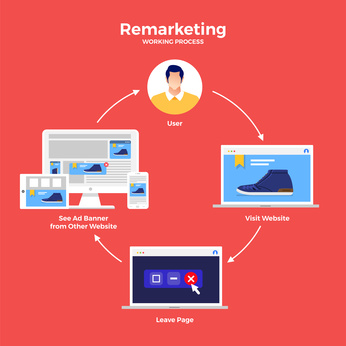Google’s brand new dynamic remarketing feature is still in beta mode. But once Google releases it to digital marketers and eCommerce businesses everywhere, this new feature will change the Google ads platform remarkably.
Dynamic remarketing campaigns are the future of PPC ads. Regardless of your business type, you’ll want to make good use of this new, exciting feature as soon as it’s made public. In today’s article, we’ll explain what Google Ads dynamic remarketing is, how it works, and why you should plan to include it in your future Google Ads marketing campaigns.
You might also be interested in WHY ARE GOOGLE ADS CALL-ONLY ADS GETTING CLICKS BUT NO CALLS?
Why is remarketing important?
Remarketing is an effective, and unobtrusive way of keeping your products and services in front of targeted leads. Most of the people who visit your site aren’t ready to purchase right away, so you want a way to get your offerings in front of them again. Remarketing on Google enables you to continue advertising to these leads across the Google Display Network, on Google search, and on your website itself.

How is dynamic remarketing different than the current remarketing ads on Google?
It’s crucial that eCommerce sites have a Google Merchant Account set up to promote their business. Within Google ads (AdWords) merchant accounts are starting to become incredibly important for feeding your product listing ads and product extensions into your remarketing campaigns.
It’s easy to set up a remarketing campaign, but most people make the mistake of having a remarketing strategy that’s way too simple and generic. Most remarketing campaigns are set to capture “all visitors” on an eCommerce site and funnel them into a broad remarketing strategy.
Failing to segment visitors won’t do you any favors, though.
A person who researched a pair of men’s shoes on your site probably won’t be interested in a pair of children’s dress shoes. But segmenting visitors based on what they did while on your site is the most effective way to remarket to potential customers. Remarketing is a way of targeting your visitors on a customised, individual level for maximum effect.
But this strategy requires a significant amount of time and effort. It’s incredibly nuanced. And while it may not be too terrible of an undertaking if you only have, say, a dozen offerings, what happens if you have hundreds or thousands? It will take you a massive amount of time to create specific audience segments and unique, effective image ads for remarketing purposes.
For many digital marketers, the hardest part of remarketing is generating image ads for every single product or service they have for sale. But with the new dynamic remarketing option from Google, Google will create ads for you that include price, your choice of text, your image, and each dynamically created ad will be designed based on the actions of your website visitors.
Once the feature exits beta and becomes widely available, you won’t have to create each ad from scratch. Plus, you’ll be able to reach your website visitors with focused, customised messages based on the products or content they interacted with when they landed on your site. In the near future, it’s going to be easier and more lucrative than ever before to remarket to your website visitors.
How does dynamic remarketing work?
When someone visits your website but doesn’t make a purchase yet, chances are they browsed your content, followed an ad to your site for a specific product, or they researched a product. With dynamic remarketing, you’re using Google’s advanced algorithms to track what visitors did on the site, and then you’re regenerating ads across the Google Display Network to show these previous visitors products or services that they are interested in.
With dynamic remarketing, you’re able to either tap into a recent interest of theirs or rekindle an old interest to drive conversions. Also, you can follow up with previous buyers to drum up renewed interest in your brand. If someone bought a pair of shoes from you, perhaps they’d also be interested in a pair of socks.

First, you’ll have to set up a Remarketing Tag on your eCommerce site. This tag will pull product identification numbers out of your merchant feed, and then send them to Google. What Google will do is match those product ID numbers to your merchant center feed and use the information to create your dynamic ads.
Remarketing tagging, though, requires coding knowledge. If you have an eCommerce site, then you’ll need a good understanding of JavaScript. Otherwise, you’ll want to get an experienced developer to get you started with remarketing tagging. Dynamic remarketing, in essence, uses AI and machine learning to understand what website visitors want to buy eventually. Once the system figures out what the user is looking for, it will combine the user’s intent with their demographic information, such as:
- Age
- Gender
- Income
And many other factors to match the visitor with your products. Google will evaluate the products in your feed based on their relevance to the visitor, their overall performance, and any other components that Google thinks will be most likely to entice the visitor into making a purchase.
What else do you need to get started with dynamic remarketing?
-
A Product Feed or a Service Feed
You’ll need to create a feed that includes all of your products and services, and details about each item. Google will pull information from the product or service feed to develop relevant, dynamic ads for your business. If you’re a retailer, you’ll want to upload your feed to the Google Merchant Center. Otherwise, you’ll want to upload the feed to the Business Data Section of your Shared Library.
-
A Tag with Custom Parameters
You’ll need to add the dynamic remarketing tag with custom parameters to every page on your site. The tag will add visitors to remarketing lists and will segment them along with the IDS of the product or service feed items they’ve viewed. The tag is in the “Audiences” section of your Shared Library.
-
Responsive Ads
You’ll want ads that will correctly format for a multitude of viewing devices and platforms. You can create responsive ads in the ad gallery.
How will dynamic remarketing ads benefit businesses?
Half of all conversions come from returning visitors. With dynamic remarketing ads, you’ll be able to quickly, efficiently, and effectively remarketing to previous website visitors, increasing your conversion rates and your sales numbers. There are many additional benefits that dynamic remarketing ads offer businesses.
- Feeds are simple but powerful. You can create basic .csv, .tsv, or .xlsx feeds for your products or services. Google ads product recommendation feature pulls the products from your feed and then determines the best combination of products for each ad, based on its popularity and what the visitor did on your site. It’s incredibly convenient for digital marketers, but it’s an effective way to remarket to previous visitors, too.
- Ads can scale with your products and services. You can pair your offerings with dynamic ads, thus scaling your ads over your entire collection of inventory.
- Real-time bid optimisation. Google ads can accurately calculate the best bid for each impression with enhanced CPC and conversions optimiser.
- Effective layouts. Google Ads can predict which ad layout is going to appeal the most for each person.
- Google ads dynamic remarketing saves time and effort. You won’t have to create new ads and spend hours optimising and tweaking ads for maximum conversion rates. Google will take the guesswork out of remarketing for you with sophisticated machine learning.
For businesses to stay competitive, they will want to take advantage of this unique opportunity from Google. Dynamic remarketing ads will enable you to harness the power of machine learning to increase your conversion rates and the loyalty of your customers.
Over To You
But making the most of this new offer from Google takes a considerable amount of knowledge of how Google Ads work and how best to optimise them. Here at Australian Internet Advertising, we’ve been assisting dozens of different verticals with effective Google Ads campaigns. Contact us today and see how we can help you increase your conversions and grow your sales numbers with effective remarketing strategies form Google AdWords.






![How much does SEO cost in Australia? [Updated August 2024] | AIA](https://aia-blogs.aiad.com.au/wp-content/uploads/2024/05/how-much-does-seo-cost-in-australia-150x150.jpg)



